| 1 | One of India’s most common |
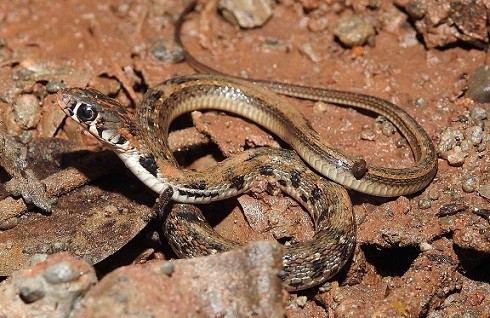
Unlike the Indian cobra and monocled cobra, a dastardly duo which have carved out southeast Asia between them and rule it through fear and intimidation, there’s one snake which illustrates a better way, which has managed to be extremely common without using brute force: the buff-striped keelback (Amphiesma stolatum).
This is a small snake found in moist areas, which appears in the vast majority of India, Bangladesh, Cambodia, Vietnam and the northern half of Thailand. Buff-striped keelbacks are non-venomous and stick to the ground, rarely climbing trees. They’re usually found near a water body, whether it be a reservoir, lake, marsh, rice paddy or stream.
Amphiesma stolatum is one of the most docile snakes in India. They virtually never bite, even if repeatedly harassed, and in several local languages, its name translates to “the snake that cannot kill”. Its main strategy is to dart away and hide in vegetation, occasionally spreading its scales to reveal startling blue skin between them.
While buff-striped keelbacks associate with water, they tend to stay on the shores, only entering the depths when strictly necessary. During monsoon season, they travel further afield, and can be found in damp agricultural fields and meadows, sometimes nosing around in puddles. This is a common species, which is nowhere close to being endangered. Buff-striped keelbacks are found in all moist areas of India, and are plentiful in Sri Lanka.
| 2 | One classic ID sign (patterns) |
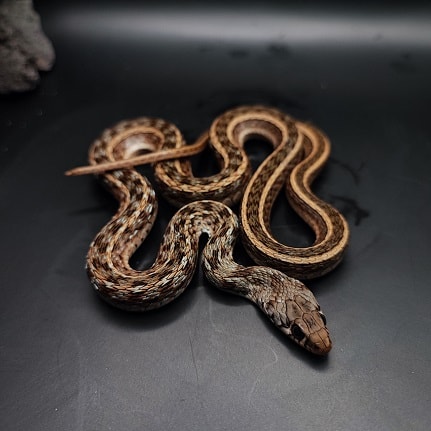
Buff-striped keelbacks are a relatively small species at just 50-70cm, and a maximum of 90cm. From a distance they look murky, like the puddles they splash around in, but up close, buff striped keelbacks have some of the most memorable patterns of an Asian water snake.
Like a US garter snake, they have a series of parallel stripes, which are lighter-coloured, stretching down the spine and the flanks. The interesting thing is the checkered, blotchy markings between these stripes. These are strong and noticeable on the upper back and neck, but gradually fade in intensity, before disappearing completely after the mid-body. See the picture above for a great example.
This fading checkered pattern is consistent regardless of colour, as this is a variable snake in its shades, typically beige/brown, but often orange or even red. A few have neon blue or grey speckles. Their tongue is black with pink and red tinges, and their pupils are round and black. There’s a kaleidoscope of colours, but to ID this Indian snake, always check for the rapidly fading checkers.
| 3 | The most common roadkill snake |
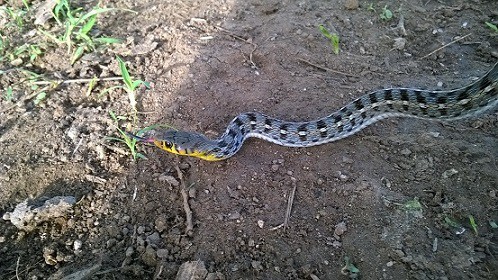
Buff-striped keelbacks enjoy many advantages as a snake. They have a massive empire spanning thousands of miles, and constantly have murky lakes and ponds to slip into to avoid roaming predators. But they also have a pitfall; that they’re perhaps the most likely snake in Asia to end up as roadkill.
The study happened on a 64km long highway through India’s Kaziranga National Park, passing from north to south. It was a conservation project, aiming to analyse humanity’s nefarious impact on its serpent neighbours. A whopping 25 snake species were found dead on the road overall, but none more so than the buff-striped keelback, which was detected 142 times. Well back in second and third place were the checkered keelback and painted bronzeback, at 101 and 80 deaths respectively. One relatively common snake which rarely appeared was the trinket snake (Coelognathus helena), at 22 deaths. King cobras were found once.
An earlier 2004 study was similar, again testing India’s Kaziranga National Park. 17 snake species were found this time, with the buff-striped keelback ranked in 2nd at 9 deaths. The eastern catsnake (Boiga gokool) came first at 14.
While loving lakes and rivers, buff-striped keelbacks are comfortable on land and relatively adventurous. They can hop between temporary rain pools, and their eggs have been found beneath rocks on plains far from permanent water bodies. They clearly don’t fear the warm tarmac of roads either, unlike some species, where roads are like a clear dividing line that they can’t cross (e.g. a prairie kingsnake). If you’ve always dreamt of visiting an Indian national park, and are speeding merrily down the highway towards the visitor’s centre, this is the most likely snake to run over.
| 4 | Diet: mainly frogs and toads |
The diet of a buff-striped keelback was analysed in 2000, using 117 snakes gathered from India’s Assam state. Before this, most casual records were of buff-striped keelbacks eating frogs and toads. Would the old assumptions hold up, or be shredded by more advanced knowledge? They held up, as toads and frogs made up 87.5% of prey identified.
93 of 117 snakes had prey in their stomach, and other chunks included 5.97% geckos, 1.02% skinks, and 1.67% Typhlopidae blind snakes. The most abundant family consumed was Ranidae, the true frogs, at 53.24%. The true toads (Bufonidae) made up 12.67%. Insects were also found in their stomachs, but only in keelbacks less than 12 grams in weight.
There was also a captive experiment, and the keelbacks happily gobbled up a variety of amphibian prey: Tapei grass frogs, ornate narrow-mouthed frogs, Asian rice frogs, Asian common toads, Indian bullfrogs, etc. The keelbacks used ambush hunting, but were kind of cowardly, as if their prey noticed them and stated approaching aggressive, they automatically switched to defensive mode, giving up the hunt.
| 5 | Aims for the head |
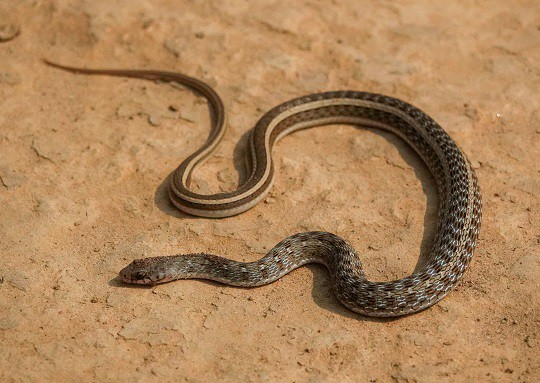
Buff-striped keelbacks proved to be a relatively fast swallower, with times taken varying from 20 seconds to 6 minutes. One factor was where they bit the snake initially. 70% were grabbed by the head, and 10.5% by the tail. Most snakes swallow their prey headfirst, so this makes sense, but 19.5% were seized by their sides. This necessitated an awkward manoeuvre to redirect the prey, by shifting its left and right jaws to gradually walk its mouth across the prey.
The buff-striped keelbacks seemed to use a mixture of scent and visuals, as they flecked their tongue repeatedly, but were only interested in moving prey, as though they couldn’t detect one that was stationary (unlike a blunt-headed tree snake).
The buff-striped keelbacks had no qualms about eating large meals. 21-35% of their own body weight was typical, while the largest meal was 47.85% of their own mass. This is larger than average; a black mamba’s meals average at just 4% of its own weight, and a Spanish horseshoe whipsnake’s at 14.3%.
| 6 | Also preys on insects |
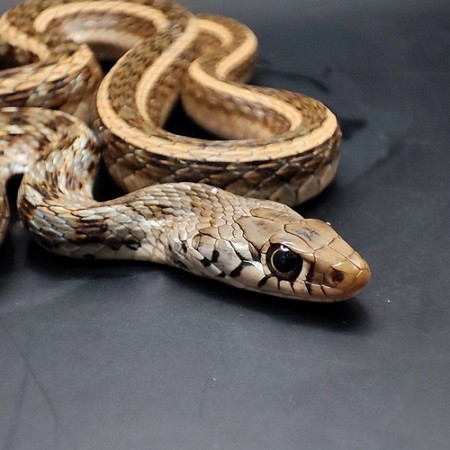
The best study before this tested buff-striped keelbacks from the Andhra University campus in India. The results were slightly contradictory, with a diet featuring 28.76% frogs and 12.28% toads with a combined total of 41.06%. This is similar to above: favouring frogs, but with no hesitation about devouring toads either. However, they made up a lower share of their diet collectively.
Next came fish at 10.23%, skinks at 7.61%, scorpions at 7.16%, insect larvae at 5.26%, and grasshoppers at 5.0%. Then there was Typhlops blind snakes at 8.37%, which is very consistent with the first study. These are underground snakes with shrivelled eyes, which generally come to the surface only after heavy rains, and buff-striped keelbacks seemingly have a taste for them. A classic Indian species is the beaked blind snake.
The buff-striped keelbacks also had a huge amount of sediment and vegetable matter in their bellies. They must be something of a sloppy eater.
| 7 | A strict daytime hunter |
The buff-striped keelbacks began hunting early in the morning at 7:30, in a prowling session lasting for 2.5 hours. Then there was a second session at 17:00, which ended at sunset. Inbetween, they took refuge in the nearest shelter they could find. Termite nests are one land shelter buff-striped keelbacks have been found in. Mid-afternoon, meanwhile, was their favourite time for drinking water.
The snakes were starved in a captive experiment, and “All the adult snakes showed considerable tolerance to starvation stress“. They lost no weight in the first 6 days, although after 15 days, their weight loss rapidly accelerated, reaching 12.7%. The keelbacks then became less active, entering energy saving mode. Buff-striped keelbacks can go time without eating, but not months or even years like a blood python.
Buff-striped keelbacks are a very consistent day-faring (diurnal) snake. As of 2017, nocturnal hunting had only been observed three times, one case involving a frog at 20:09, which was successfully swallowed in 17 minutes. The common factor in all three cases was hot, humid weather, in which the buff-striped keelback was in its element.
| 8 | Rare morphs you might find |
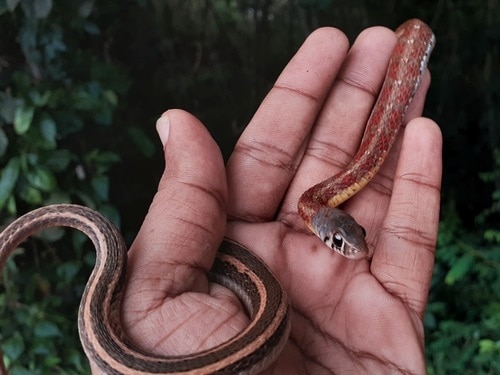
Buff-striped keelbacks are a kaleidoscope of colours. This image shows a blue morph, and one of the most stunning ever was observed in India’s Maharashtra state. It was a lava flow of a keelback, a striking mixture of vivid red and dense midnight black. Its belly was pale, but from above, red-black was all that was visible. It looked almost like a different species, but despite this, the familiar pattern of checkers on the upper body fading into stripes on the lower half was consistent.
The stripes almost looked like red laser beams, while its tail was a pure juicy red. The head was more olive-coloured. Weirdly, female buff-striped keelbacks are known to gain some red colouration around the neck during breeding season, even if they’re beige or brown normally. The snake measured just 53.3cm, and scale counts proved it to be an Amphiesma stolatum.
The most extreme point of the buff-striped keelback’s range lies near Islamabad, capital of Pakistan. At the opposite end, nearly 3000 miles away, the easternmost point lies in Taiwan. The Amphiesma keelback genus contains just two species, and the other is the Wynad keelback. This version is far less common, known only from the damp Western Ghats hills of southern India.
| 9 | Leads a brutal life |
While both are non-venomous, the buff-striped keelback completely lacks the brutish aggressive side that a checkered keelback suddenly shows. The latter is another common Indian species, found everywhere swimming through lakes, swamps, reservoirs and rivers. Like a UK grass snake, it’s hard to provoke buff-striped keelbacks into delivering even a non-venomous bite. They fall victim to predators, such as the banded krait (Bungarus fasciatus), a notorious snake-eating snake. The tricarinate sea turtle is another confirmed predator.
Then there’s a sudden dark shadow followed by a nightmarish pecking from above: the domestic chicken is another predator. Though buff-striped keelbacks don’t appear in cities, they’re relaxed about slithering past buildings in more rural locations, such as chicken coops.
They also suffer hunting mishaps. Across the world, there are dedicated snail eaters like the keeled slug snake of Thailand, with special retracting jaws designed to suck their slimy inner bodies free. In Manipur state, a buff-striped keelback was observed trying to get in on this game. It seized hold of its calcified prey, but unfortunately, its jaws became lodged in the shell. The keelback tried to free itself for over an hour, before the scientists decided to intervene. This incident proved why you should leave it to the professionals, why it’s not any old snake that can hunt snails.
| 10 | Buries its eggs in soil |
Buff-striped keelbacks are missing from southern Thailand, as their territory only just reaches the Bangkok countryside. They’re not found in peninsular Malaysia or Singapore, for example. In April 2008, scientists found a buff-striped keelback lying half-dead in a drainage gutter, on a road just outside Kaeng Krachan National Park, Kaeng Krachan. This was one of the most southerly observations in Thailand so far, perhaps the very outskirts of their empire.
Instead of rock crevices like a rattlesnake, buff-striped keelbacks hibernate 25-45cm deep in soil, nestled amidst grass roots. Their eggs are snowy white, and slightly more elongated than a chicken’s egg.
The eggs measure 2.5-1cm and arrive in batches of 4-16, nothing spectacular compared to India’s checkered keelback, which occasionally surpasses 100. Newborns crawl out of the shell at 13-17cm. While mothers are hardly caring, they remain with the eggs until they hatch. Buff-striped keelbacks are mainly a lowland species, and reach a record elevation of 1420 metres above sea level.
